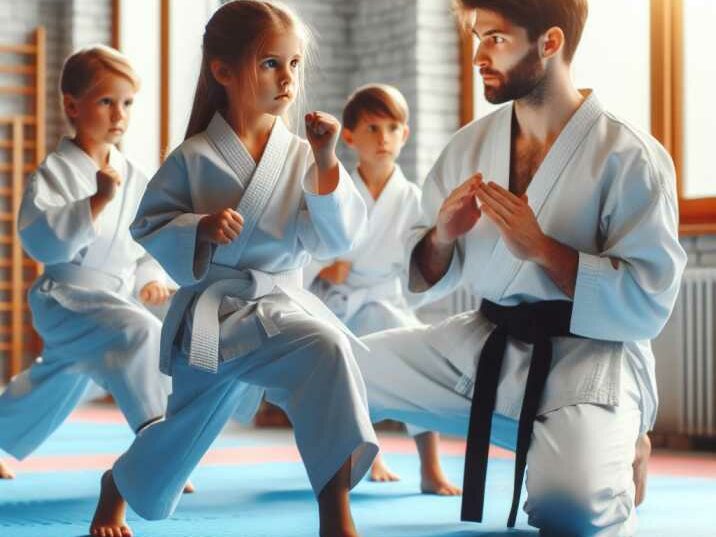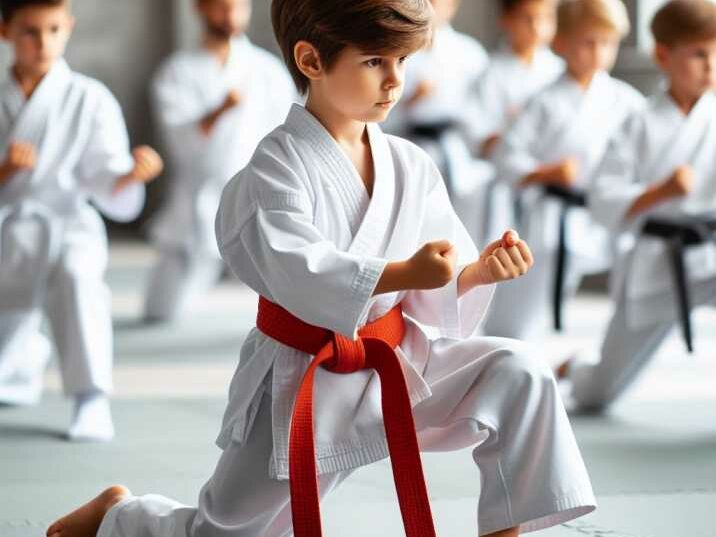Introduction:
Table of Contents
Karate is an ancient martial art that originated in Okinawa, Japan. It is not just about fighting; it is also about discipline, respect, and self-control. Many parents and teachers want to introduce karate to their children, but they may not know where to start. In this article, we will explore how to explain karate to a kid in a way that is easy to understand and engaging for young learners.

Table of Contents:
- What is Karate?
- Origin and History
- Principles of Karate
- Why Teach Karate to Kids?
- Benefits of Karate for Children
- Developing Discipline and Focus
- How to Explain Karate to Kids
- Use Simple Language
- Demonstrate Basic Moves
- Relate it to Everyday Situations
- Teaching Karate Safely
- Importance of Proper Supervision
- Warm-up and Stretching Exercises
- Making Karate Fun for Kids
- Incorporate Games and Challenges
- Rewarding Progress and Effort
- Frequently Asked Questions (FAQs)
What is Karate?
Karate is a martial art that focuses on self-defense techniques using various strikes, kicks, and blocks. It emphasizes physical fitness, mental discipline, and respect for others. The word “karate” means “empty hand” in Japanese, highlighting the fact that practitioners do not use weapons.
Origin and History:
Karate originated in Okinawa, Japan, during the Ryukyu Kingdom era. It was developed as a form of unarmed combat to defend against armed attackers. Over time, it evolved into a structured martial art with its own set of techniques and principles.
Principles of Karate:
Karate is guided by several core principles, including respect, humility, and self-control. Practitioners are taught to use their skills responsibly and avoid unnecessary conflict. Discipline and focus are also fundamental aspects of karate training.
Karate Terminology:
- Sensei: Japanese term for instructor or teacher.
- Dojo: Traditional Japanese training hall where karate classes are held.
- Gi: Karate uniform consisting of a jacket and pants, often worn with a belt.
- Kata: Preset forms or sequences of movements practiced in karate to develop technique, balance, and coordination.
- Kumite: Sparring or controlled fighting practice between two students.
- Dan: Black belt rank in karate, indicating a high level of proficiency and expertise.
Why Teach Karate to Kids?
Teaching karate to kids offers numerous benefits, both physical and mental. It helps improve coordination, strength, and flexibility while instilling valuable life skills such as discipline, respect, and perseverance.
Benefits of Karate for Children:
- Improves Focus and Concentration: Karate requires students to focus on their movements, techniques, and surroundings, which can enhance concentration skills both in and out of the dojo.
- Promotes Self-Discipline: Karate training instills discipline by requiring students to follow rules, show respect to instructors and peers, and adhere to a structured curriculum.
- Enhances Self-Defense Skills: Learning karate empowers children with practical self-defense techniques that can help them protect themselves in threatening situations.
- Boosts Social Skills: Karate classes provide opportunities for children to interact with peers in a supportive environment, fostering teamwork, communication, and camaraderie.
- Builds Confidence: As children progress in their karate training and achieve new milestones, they gain confidence in their abilities and develop a positive self-image.
Developing Discipline and Focus:
Karate training requires discipline and focus, which are essential qualities for success both inside and outside the dojo. By following instructions and practicing regularly, children learn the importance of commitment and dedication.

How to Explain Karate to a Kid?
When explaining karate to kids, it is important to use simple language that they can understand. Avoid technical jargon and focus on basic concepts such as punches, kicks, and blocks. Demonstrate basic moves and encourage children to practice along with you. You can also relate karate to everyday situations to help them understand its practical applications.
Teaching Karate Safely:
Safety should always be a top priority when teaching karate to kids. Make sure that children are supervised at all times, especially when practicing techniques that involve contact. Begin each session with a warm-up to prevent injuries and encourage flexibility.
Importance of Proper Supervision:
Adult supervision is crucial to ensure that children practice karate safely and correctly. Certified instructors should oversee training sessions and provide guidance on proper technique and form. Parents can also play a role in reinforcing lessons learned in class.
Warm-up and Stretching Exercises:
Before engaging in any physical activity, it is important to warm up the body and stretch the muscles. Simple exercises such as jumping jacks, lunges, and arm circles can help prepare children for karate practice and reduce the risk of injury.
Making Karate Fun for Kids:
To keep kids engaged and motivated, it is important to make karate fun and enjoyable. Incorporate games and challenges into training sessions to keep things interesting and interactive. Reward progress and effort with praise and encouragement to boost children’s confidence and enthusiasm.
Incorporate Games and Challenges:
Games and challenges can make karate training more enjoyable for kids while helping them develop important skills such as balance, coordination, and timing. Try incorporating activities like obstacle courses, relay races, or even karate-themed scavenger hunts.
Rewarding Progress and Effort:
Recognizing and rewarding children’s progress and effort is essential for building confidence and motivation. Praise their achievements, no matter how small, and encourage them to set goals and work towards them. Positive reinforcement helps create a supportive learning environment where children feel valued and empowered.
Safety Tips for Karate Practice:
- Start Slowly: Beginners should start with basic techniques and gradually progress to more advanced moves as they gain experience and confidence.
- Use Protective Gear: When practicing sparring or contact drills, students should wear appropriate protective gear such as headgear, mouthguards, and padded gloves.
- Listen to Your Body: Encourage children to listen to their bodies and speak up if they experience any pain or discomfort during training. Rest and proper hydration are essential for preventing injuries.
- Supervise Practice Sessions: Parents should ensure that children practice karate in a safe environment under the supervision of a qualified instructor or experienced adult.
- Warm Up and Cool Down: Always begin and end karate sessions with warm-up and cool-down exercises to prepare the body for activity and reduce the risk of injury.
Karate for Special Needs Children:
- Many karate schools offer programs specifically designed for children with special needs, including autism, ADHD, and physical disabilities.
- Karate can provide these children with a supportive and inclusive environment where they can learn valuable skills, improve coordination, and build self-confidence.
- Adaptations may be made to accommodate individual needs, such as modifying techniques or providing extra support from instructors or assistants.
Conclusion:
In conclusion, How to explain karate to a kid? Karate is not just a martial art; it is a way of life that teaches valuable lessons in discipline, respect, and perseverance. By introducing children to karate at a young age and providing them with a supportive learning environment, parents and teachers can help them develop physical fitness, mental toughness, and a lifelong appreciation for the art of karate. With proper guidance and encouragement, children can reap the many benefits that karate has to offer, both on and off the mat.
Frequently Asked Questions (FAQs):
- Q: Is karate safe for kids?
- A: When taught properly and under supervision, karate is a safe activity for children that promotes physical fitness and discipline.
- Q: At what age can kids start learning karate?
- A: Children as young as four or five years old can begin learning the basics of karate, but the optimal age to start may vary depending on the child’s maturity and coordination.
- Q: Do kids need any special equipment for karate?
- A: Basic karate attire typically includes a gi (uniform) and a belt to signify rank. Some schools may also require additional protective gear such as gloves and shin guards for sparring.
- Q: How often should kids practice karate?
- A: Consistent practice is key to mastering karate techniques. Most schools recommend attending classes at least two to three times per week, supplemented by regular practice at home.
- Q: Can karate help with bullying?
- A: Learning karate can help boost children’s confidence and self-esteem, making them less likely targets for bullying. Additionally, karate teaches valuable self-defense skills that can empower children to stand up for themselves assertively but non-violently.


